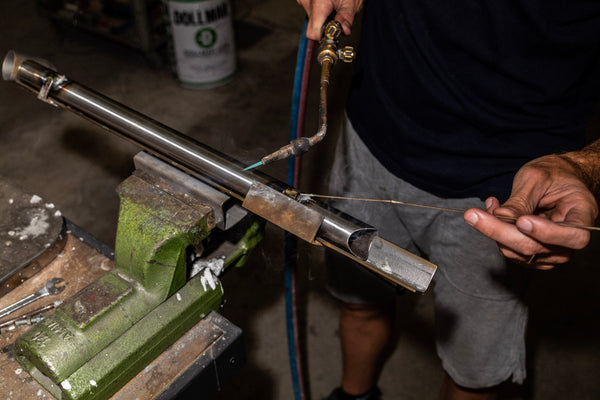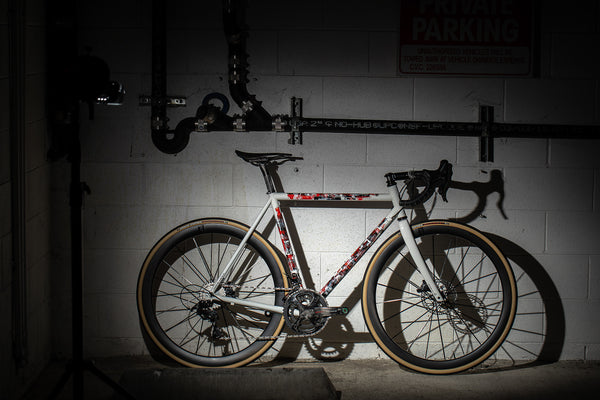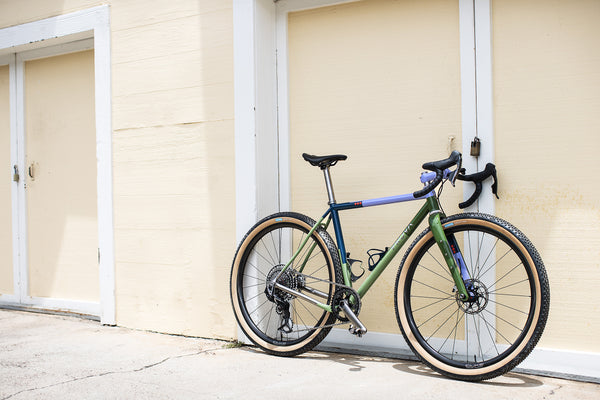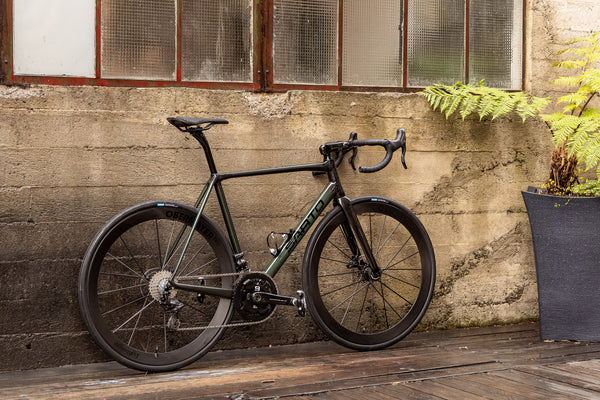ONE MORE TIME WITH FEELING
Writing a review about a new bike that's so similar to the last one is a shred of a mammoth task of marketing doublespeak. When Open Cycle's UPPER dropped, we don't want to say we were underwhelmed, but we weren't blown away. As we mentioned upon its release - little has changed. In fact, the frame's mold is the same as its UP progenitor - all that's differed is the carbon layup schedule, slacking 220g from the frame's weight, and the addition of flatmount. A new fork was also introduced introduced (aka U-turn), lighter than the off-the-shelf 3T model featured on the UP, and utilizing the road standard 12mm thru-axle instead of a 15mm. And, sorry-not-sorry, we have some bad news: Short of building into an even-lighter bike, the UPPER's new layup makes no discernible difference in ride quality, for better or worse. Why? Because we ride these bikes with the tires they're made for - big, fat, plush rubbers with silly-low pressure. Any sort of tangible minutiae of the carbon's orientation that would turn into a difference in ride feel to a human is lost in the pillowy feel of a 48mm slick aired to 35psi. It's sort of like asking if you can taste the obscure varietal saffron in the 98-ingredient paella during a drunken night on the Valencian coast - if it doesn't suck, it's all good.

So then, where does that leave us when it comes to reviewing Open's new darling? Admittedly, a bit empty-handed. It feels pretty much like the last one, but lighter. It goes uphill quicker, all things equal. Of course, we could also quit drinking imperial stouts and achieve the same in the space of a week or two. It comes in black (and ONLY black, unless you're fancy and want custom paint - which, of course, we do). The U-Turn fork is slimmer, flatmount, and cuts a nicer profile than the bulbous 3T unit, but its 12mm axle does give up a bit more flex than the burly 15mm mountain bike-derived thru-bolt of the UP. Aside from all that? This bike is essentially the same - same tire clearance, same "Relentless Simplicity" design mantra, and same purpose. Which is to say, almost everything. Which takes us deep into the weeds in our next tangent.

THE BIKE FOR EVERYONE
Collectively, we'd like to thank the crew at Open for helping crack the cycling industry's staid mindset wide open. For the past few decades, we've had an obsession with road racing. It's not a bad thing, per se (because hot damn, do we love go-fast race bikes, bike racing, and weighing out 100g of chicken breast for our spinach salads), but it's led to the development of bikes across the spectrum that are less than capable, less than comfortable, and at the end of the day, not the ideal tool for the job (read: Enjoyment) for most riders. They've been constrained by minimal tire clearance, limited gearing, and an industry only building performance componentry that works within that stringent criteria. Finally, some fourteen years ago, we saw the reawakening of the "everyman" bike category with Specialized bringing the Roubaix to the fore. It was a bike inspired by racing, but with the edge taken off by taller geometry, ride cushioning provided by ridiculous elastomer inserts, and generous (for the time) tire clearance (28mm - what will mother say?). Of course, it's taken widespread acceptance of disc brakes on road bikes for things to really take off, and for things to get really silly. Or really awesome, depending on how you look at it. Everyone was inching towards the bike that wasn't quite a road bike, but wasn't a mountain bike (again, here's looking at the Big S and the first-gen Diverge); but nobody did a cannonball into the murky abyss like Open with the UP, at least from a production carbon standpoint. We've said it once, and we'll say it again - the bike broke the mold. Road racing geometry, huge tires, and serious consideration for the ridiculous. We've been punishing the UP - and now the UPPER - for over a year. Its unique position in the quiver lends to unique approaches towards gear and riding that we haven't thought about before, sort of like the first time we figured out how to poach an egg instead of slapping it into a frying pan. While we certainly have a wealth experience with mountain riding, Open turned everything on its head applying those concepts to a drop-bar, disc-equipped bike.

WHAT WE'VE LEARNED
TIRES: The crux of the UPPER's capability comes from its class-leading tire clearance, paired with a stubby 420mm rear-end thanks to a dropped chainstay. Huge, slick tires with supple casings (like a standard road racing tire that's three times as big) are incredible, providing astonishing levels of grip with low rolling resistance in a bevy of situations, from rooty singlerack to glassy pavement. If we had our pick of rubbers for an Apocalypse bike, they'd probably be something like Compass Cycle's Switchback Hill, a 650b/27.5" tire measuring a beefcakey 48mm across, or if things get wet, a Schwalbe Thunderburt in 2.1".

WHEEL DIAMETER: Definitely matters. This isn't something we've paid a lot of attention to before, as road tires don't tend to vary much in height within the tight tolerances of a racing frameset. But, when it comes to squeezing every bit of capability from the UPPER's generous clearance without compromising handling, we go with the aforementioned 650b/27.5" Compass. Why? Exactly what we laid out above - we're all about the big volume for maximum capability. Unfortunately, the even-bigger 700Cx44mm Compass slick turns the wheel into an outsized pie Ferris Wheel, hoisting the bottom bracket what feels like ten stories into the air. This leads to ponderous, ungainly handling, and a bike that resists leaning into corners because its center of gravity is so high. So how do we maintain big volume, big contact patch, big traction, and low rolling resistance? Simple. Just make the rim smaller. Overall, the 650b/48mm combo is about akin to a 700C/28mm road setup when it comes to overall diameter (wheel/tire together). Grip wins, and the bike turns into an absolute ripper on paved descents with the BB dropped. The contact patch of the big tire is so big, though, that one needs to actively counter steer the bike to hit a corner apex - much like riding a motorcycle instead of a bicycle. 
STEMS SLIP: We're no strangers to riding off-road, but normally we've been on mountain bikes with flat handlebars. On drop bars, things get tricky in rough terrain, as the bulk of the leverage over the front of the bike is far in front of the stem clamp, which can lead to the bars suddenly slipping forward. We've learned to use liberal amounts of installation compound on clamping surfaces, as well as stems that seem to do a good job of evenly distributing load across the clamp, like the Zipp Speed SL.

DISC HATERS BEGONE: Being able to get full braking power from the hoods in technical, off-road situations is a godsend, let alone in muddy conditions. Bring on the rotor burns and faked calf slashes.

ONE-UPPED: As on the mountain bike, 1x reigns king. SRAM's 10-42t 11-speed setup is the bee's knees. Offroad, the gaps in gearing are fairly benign, and the clutched rear derailleur paired with a narrow-wide chainring is bulletproof when it comes to chain drop when things get rough. Unfortunately, given the off-road tilt of the original 10-42t cluster, gear jumps towards the smallest cogs on the cassette become enormous, which are frustrating when motoring on flat pavement or a downhill. Here's to hoping that SRAM brings the 12-speed Eagle cogset to drop bars soon, with a tighter-range gearing option - like a 10-36t.
RUBBER SADDLES: The Brooks Cambium is revelatory. We poo-pooed it when it was first released, but for off-road capable bikes, its all-rubber construction, while a bit weighty, damps vibration like an old Cane Creek Thudbuster. If the backside agrees with the shape (it comes in three widths with a cutout option), it's money - especially in exclusive CHPT3 trim.

PEDAL ADVISORY BOARD: If one can tolerate the sloppy feel of a standard Shimano SPD mountain pedal, they remain the best solution for a two-bolt shoe. We've tried desperately to get Speedplay's SYZRs to work for us, but their propensity for sudden, unexpected release negates their other benefits (and there are many). That said, we love the Speedplay Pavé, their Classics riff on the venerable Zero road pedal that can't get clogged with mud or debris, but it requires a three-bolt road slipper. We'll admit to having a spare pair of "gravel" road shoes that work in this application, but don't expect extensive hiking capabilities - or for them to look anywhere close to presentable after a few rides.

WE, FOR ONE, WELCOME OUR NEW CARBON OVERLORDS: Everything in 2017 is so damned durable. If you'd told us ten years ago that we'd be able to build a 15lb off-road capable bike, put it through an 800km torture chamber for five days under a proverbial bull in a china shop and have it come out the other side relatively unscathed, we'd have asked you about your mental health. It's simply astonishing how strong performance equipment has become.

TUBELESS IS KING: This goes without saying, but there are still holdouts. When it comes to big tires and low pressures, there's absolutely no reason to run anything else, especially considering it's possible to mount many tubeless-ready tires these days with little more than a framepump in a hotel room (ask us how we know).

FINAL THOUGHTS
While the UPPER is genre-defining, giving Open Cycle all the credit is hasty. We view the ascendancy of gravel (and yes, we're settling on the term - deal with it) as a natural evolution of our sport, and it's here to stay. Like skiing before us taking cues from snowboarding when it came to equipment and riding style, so too is road being influenced by dirt, knobs, and empty spaces unperturbed by automotive traffic. Open's "Relentless Simplicity" mantra is one of the purest expressions of what so many of us who've raced, trained, and ridden on the road have felt for decades. It's the simple marriage of the laid-back nature of riding on dirt with the athleticism of road cycling. Has it resulted in one of the most technically advanced bicycles available? No. But, it's helped to reshape the way many of us approach riding, and it's engendered a whole new way for us to find ourselves lost on two wheels.








Back to Journal